|
The Queen Anne Furniture Controversy
By Robert Reed
One speaks the Glory of the British Queen
And one describes a charming Indian screen.
Alexander Pope, 1712.
As lovely as Queen Anne furniture may be, it is almost as controversial as it is beautiful. Centuries later, there is still disagreement on exactly what Queen Anne furniture was, where it actually came from, and who deserved to lay claim to it. One noted furniture historian concluded that because this furniture overlapped with earlier William and Mary styles and later Chippendale and Federal styles, no such Queen Anne style ever really existed. It was merely transitional, concluded Ester Singleton in the noted volume, The Collecting of Antiques.
"This explains why some authorities give late Stuart examples to Queen Anne and other authorities give to early Georgian," along with other bewildering forms.
Nor is there agreement on the true origin of Queen Anne and where it flourished best. Some American historians have suggested that rather than the traditional route through England, this light and curving furniture had been first introduced to the Colonies by craftsmen from the Netherlands. Some accounts strongly suggest that the Dutch had further refined a style which had been discovered during trade in the East Indies.
Historically, the fabled Queen Anne style is said to have derived from the reign of King William and Queen Mary, who were actually Dutch. The second daughter of James II, Queen Anne succeeded William and Mary to the throne of England in 1702.
Ironically, Queen Anne's untimely death came in 1714, well before the full emergence of the furniture style. Typically, the so-called Queen Anne period is described as flourishing from around 1720 through the 1750s. However, some suggest that indications of the style were present earlier, including the Dutch influence of using the inlaid marquetry of exotic woods.
Some references indicate that Dutch influence had already been introduced in the American Colonies by the time it reached England. They cite examples in New York and in Pennsylvania which had been brought by large numbers of immigrants from the Netherlands.
Certainly, what is not in dispute is the remarkable significance of the curving cabriole leg. The Queen Anne style was actually a refinement of the ancient form which was said to represent an animal leg from the knee down. Part of the word cabriole was based on the Latin word for “goat,” which is caper.
This curving leg characteristic, the most outstanding feature of the Queen Anne period, appeared on chairs, desks, highboys, lowboys, secretaries and tables. The knees of the cabriole legs were sometimes decorated with shells and later with the acanthus leaf. The Dutch foot or pad foot was usually used to end the cabriole leg. However in later years, especially in America, such legs were given claw and ball feet. This claw and ball aspect continued in the Chippendale period as well.
Social change also had a significant impact on furniture in the early 1700s. For one thing, it was very fashionable to collect porcelain which had been generated through the constant European trade with the East. Display cabinets were used in the homes of the wealthy, with glazed doors for viewing of the small treasures. Such cabinets were given prominent locations in household dining rooms.
Far more porcelain was collected than could be simply stored in cabinets. Written accounts of that era speak of "…great jars of China, placed one above another on every noble piece of Architecture." Another account suggested that in 1724 china was piled onto some of the cabinets and secretaries and even to the tops of ceilings.
Besides collecting china, there was drinking tea. The relatively new custom of drinking tea socially became popular, and to a certain extent, the taking of coffee and chocolate was also welcomed. To accommodate this practice, a great number of tea tables were produced by skilled craftsmen. Such tea tables came in a variety of shapes, from rectangular to round. Most of them had a tray-like molding on top. Many of the small tables had tops which could be tilted for storage when not in use.
There were also slightly larger gaming or card game tables in use and even some serving tables similar in size. However generally, the full-sized dining table was not yet widely acceptable.
Most experts agree that black walnut was the chief wood used in bringing the Queen Anne style to the public in America. Black walnut was found in abundance throughout the East Coast at the time and soon surpassed the usage of mahogany, which had largely been imported from the West Indies and brought to ports in places like Charleston and Philadelphia. However, there was also a tendency to use the best woods available in a particular region of the country. Maple was favored in New England and in Pennsylvania. Likewise, cherry wood was sometimes selected in colonial Connecticut and New York.
For the most part, veneers and inlay gradually became less important in the Queen Anne style than the very best of solid woods. The wood was highly carved, however, and Oriental lacquer was often added to fine pieces.
Whenever this flowing style first arrived in the American Colonies, there is no doubt of its effect and its endurance. It was new, it was stylish, and it came at a time of great growth in America. Some towns were growing larger and more prosperous; not surprisingly, a taste for more sophisticated furniture came with it.
Cabinetmakers with ever increasing experience and technical skills displayed a flair for carving and ornamentation that rivaled even the best Europe had to offer. The elegant tea table with its molded top and scrolled skirt found a home in America along with the chest of drawers with its molded cornice and bracketed feet.
American chairs were graceful and comfortable with essential cabriole legs and solid-splat backs. Bedsteads were tall and slender, and secretaries sported striking scroll tops. Drawer fronts, in turn, were often finished with a quarter round lap which served to conceal the space between the drawer and the frame.
Queen Anne herself may have served her country only a dozen years, but the furniture style in her name lasted for the better part of a century in America. Even beyond the American Revolution, its distinguished form could be found in smaller villages of the newly-formed country.
|
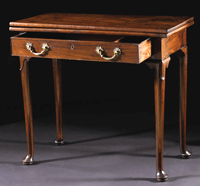
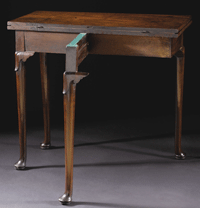
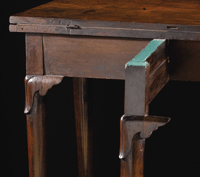
Mahogany Queen Anne swing-leg game table by an unknown maker, possibly American, 18th C. 29 x 32 x 15.5 inches, sold for $1,434 in 2007. A flip top reveals inset leather with a finely-carved design at the top and slightly tapering legs ending in pad feet. (Photo courtesy of Heritage Auction Galleries.)
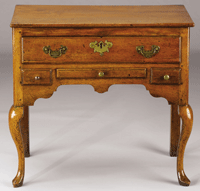
An oak Queen Anne lowboy from the late 18th c. with a rectangular top over a long drawer, above a pair of faux short drawers, raised on cabriole legs ending in spade feet. It sold for $2,509. (Photo courtesy of Heritage Auction Galleries.)
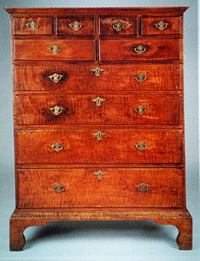
A Queen Anne chest of drawers made of tiger maple, ca.1750, New England. (Photo, Skinner, Inc.)
|